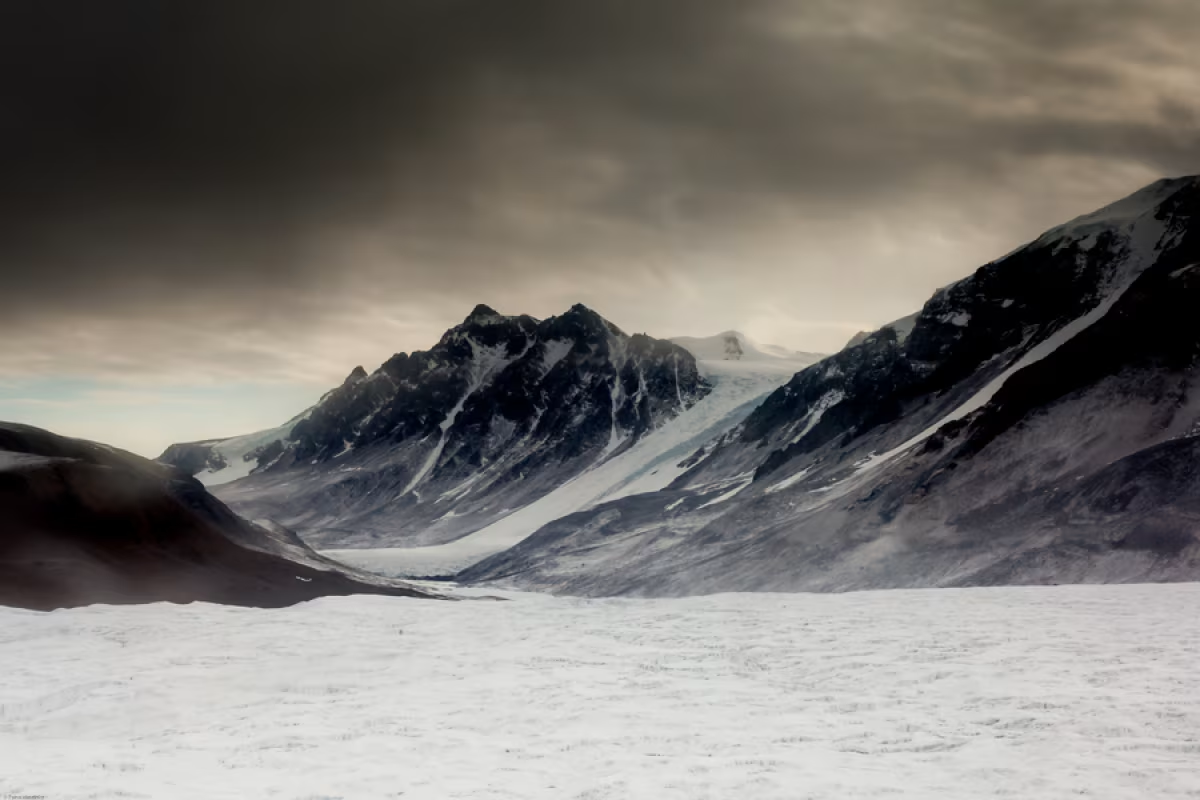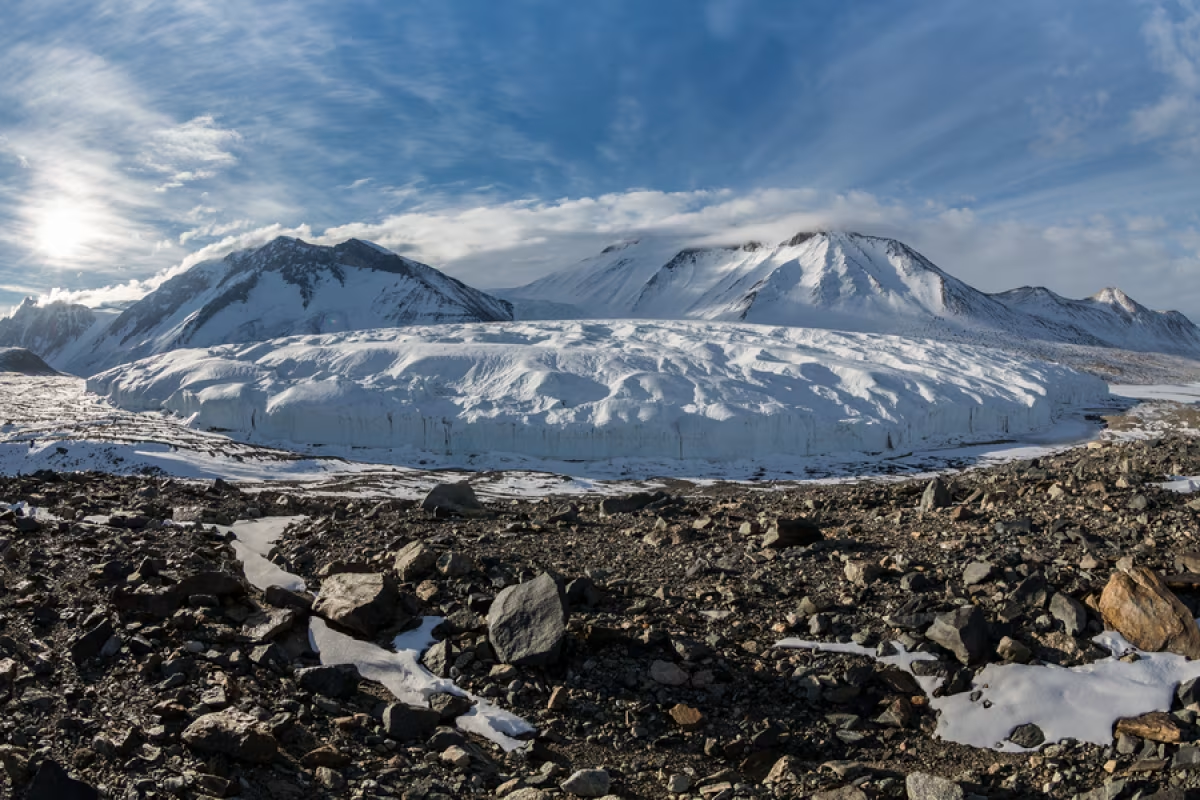The McMurdo Dry Valleys of Antarctica
Located on the western coast of McMurdo Sound, the McMurdo Dry Valleys form the largest ice-free (relatively) area in Antarctica.
Covering a surface area of approximately 4,800 square km (1,850 square miles), the Dry Valleys are unique in that their frozen lakes and extensive areas of exposed soil represent a region of Earth approaching the minimal requirements for supporting life.
In fact, low temperatures, limited precipitation, and salt accumulation make the McMurdo Dr Valleys almost more like Mars than Earth - or Antarctica.
The McMurdo Dry Valleys remain dry because the precipitation that falls as snow to the Antarctic Continent is blown away from this area by strong, dry, katabatic winds through the process of sublimation.
The result is that the only ice found in the Dry Valleys is in the form of alpine glaciers and lake ice, making the area a peculiarity in an already peculiar continent.

Antarctic life in the McMurdo Dry Valleys
When Captain Scott first discovered the Dry Valleys in 1903, he and his expedition crew believed them to be void of any life.
It turns out, however, that a large variety of aquatic ecosystems thrive in the harsh climate of the McMurdo Dry Valleys due to glacier melt-streams that flow into the ice-covered lakes.
This flow is not constant, but is dependent on a combination of factors surrounding temperature, wind, and sunlight.
The flow levels fluctuate between a trickle and a torrent throughout the day, month, and year, which means only certain organisms can survive in the unusual Dry Valleys environment.
These organisms are usually cyanobacteria, known to be "stress-tolerant" species, which also have dark pigments for protection from high UV rays.
Despite the harsh conditions, there are diverse species in the McMurdo Dry Valleys, as there are few other plants or animals competing with (or eating) them.
One of the most amazing aspects of cyanobacteria survival is their ability to kick-start the photosynthesis process within 48 hours of receiving liquid water, despite being in a virtually freeze-dried state.

The ice-covered lakes of the McMurdo Dry Valleys
Ice-covered lakes in the Dry Valleys, which have ice around 3 - 5 meters thick (9.8 - 16.4 feet) throughout the year, provide a unique habitat for life to thrive. Some of the key characteristics of these lakes include:
- Ice cover that results in a stable water column, allowing saltwater layers to persist over many years
- It limits the speed at which nutrients, that accumulate in deep waters, can return to the upper layer of the lake
- The thick ice blocks 80-99% of the sun’s energy
These characteristics lead to the Dry Valleys lakes being dark, cold with a slow supply of nutrients and a slow-growth environment for different species. The most common production found in the lakes is microbial mats on the lakebeds with the main organisms being cyanobacteria.
Despite the cold temperatures inhibiting their growth, lake mats grow in large accumulations due to limited disturbance and lack of grazing. One interesting aspect of these mats is they grow annual layers with each layer appearing as alternate bands of black (winter) and white (summer), enabling researchers to determine past temperature changes in the dry valleys.
Lake levels are determined by the volume of melt-water available, which fluctuates over time. For example, Lake Vanda’s depth has varied from 130 m deep around 5,000 years ago to bone dry levels around 1,200 years ago, leaving a brine pool. During the 1970s the lake depth was 65 m. Because of the lack of wind mixing the water, the brine pool dating from 1,000 years ago is still at the bottom of the lake.
Discovery of Antarctic groundwater in the McMurdo Dry Valleys
Recently researchers discovered beneath the Dry Valleys a salty aquifer that potentially could support previously unknown microbial ecosystems. UC Santa Cruz glaciologist Slawek Tulaczyk – a professor of Earth and planetary sciences – along with other researches gathered evidence of groundwater by using a helicopter-borne sensor to penetrate below the surface.
The study found brines, or salty water, form aquifers below the Dry Valleys’ glaciers and lakes and within its frozen soil. The study also found evidence of the brines flowing towards the Antarctic coast from around 18 kilometres inland, eventually discharging into the Southern Ocean. The study speculates the nutrients carried in the brine is released into the ocean affecting biological productivity in and around the shoreline areas.
Another discovery was the detection of microbial habitats in the surface and near-surface of the Dry Valleys: an amazing feat of life given the tiny pore spaces are filled with hyper-saline brine that stay liquid down to -15 °C. This study is part of an international, interdisciplinary team that is using an electromagnetic sensor called SkyTEM mounted to a helicopter to produce imagery of the subsurface of the Dry Valleys, with the technology developed at Aarhus University in Denmark.
The SkyTEM lead Esben Auken has flown the sensor in many places around the world and this was the first time the technology was deployed to Antarctica. Overall, the data from the project will provide scientists with a greater understanding of how the Dry Valleys have change over time and how this history influences what scientists see today.
The science of the McMurdo Dry Valleys
The McMurdo Dry Valleys Long Term Ecological Research (LTER) project is an interdisciplinary study of the Dry Valleys’ aquatic and terrestrial ecosystems. The site was selected in 1992 for the National Science Foundation’s Long-term Ecological Research Program.
With the project funding in 2010 renewed for another 6 years, the McMurdo LTER project conducts long-term ecological research with the aim of leaving a legacy of well-designed and well-document long-term field experiments and observations for future generations to improve their understanding of the basic components of the ecosystem as well as factors that cause widespread changes. Specifically, the McMurdo LTER goal is to understand the influence of physical and biological constraints on the structure and function of Dry Valley ecosystems.
A barometer of global change: the McMurdo LTER
McMurdo’s LTER project states the research conducted in the Dry Valleys is important for science as while all ecosystems are dependent on liquid water for survival seldom are there places on Earth in which a minor change in climate can affect the capabilities of organisms to grow and reproduce.
With the data collected by the LTER indicating the Dry Valleys are very sensitive to small variations in solar radiation and temperature this can provide researchers with a natural regional-scale laboratory for studying responses to human activities that alter the climate.
Importantly, Antarctic ice sheets respond to climate change over periods of thousands of years while the streams and ice-covered lakes in McMurdo’s Dry Valleys respond to change almost immediately: The McMurdo Dry Valleys will be the first place on Earth where the impacts of climate change will be observed immediately.

